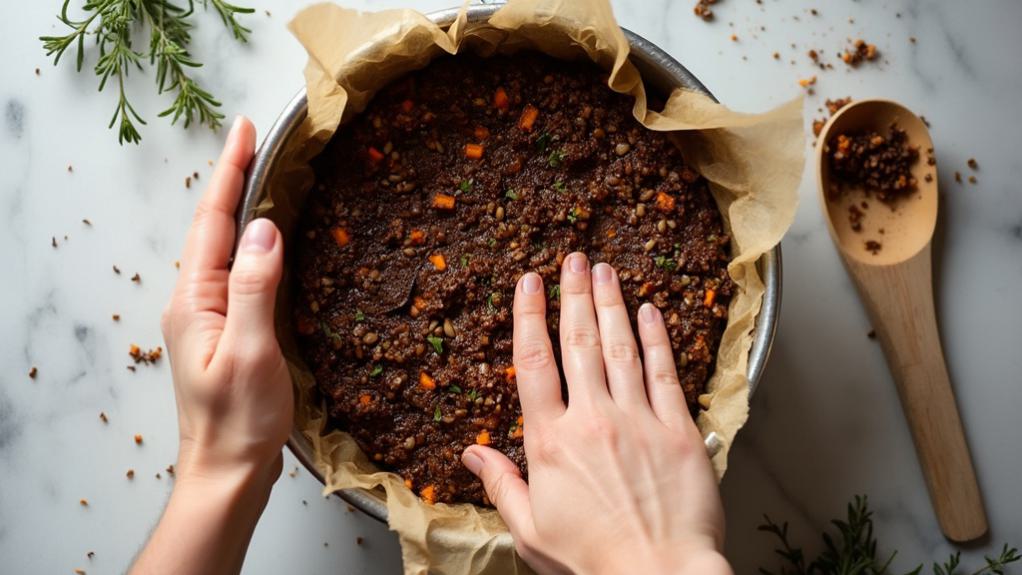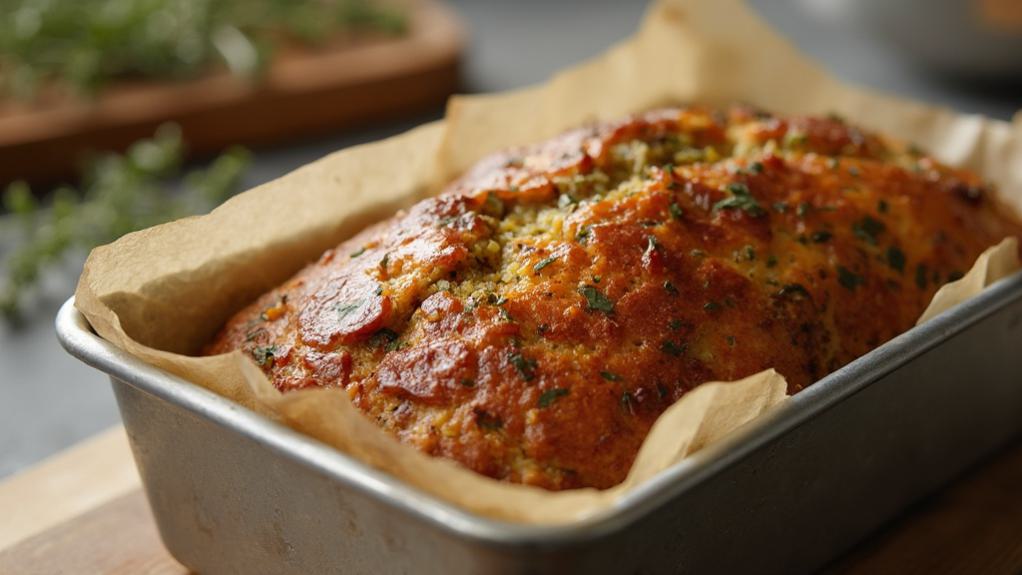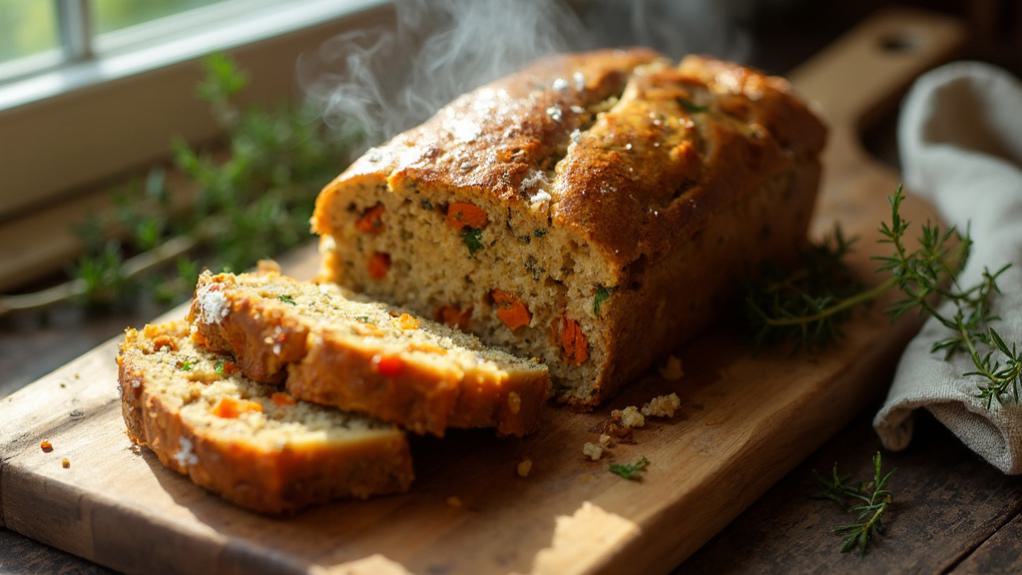If you’ve dismissed veggie loaves as dry, crumbly disappointments, I’m about to change your mind with this exceptionally moist lentil creation. As a professional cook who’s tested countless plant-based recipes, I’ve discovered that the secret lies in the perfect ratio of lentils to vegetables, enhanced by umami-rich ingredients like tomato paste and soy sauce.
This loaf has become my go-to centerpiece for both casual family dinners and elegant dinner parties, earning praise from even the most devoted meat lovers. Let me show you how to master this versatile dish that’s revolutionized my approach to meatless meals.
Recipe
A Lentil and Vegetable Loaf delivers a protein-rich, hearty main course that satisfies both vegans and non-vegans with its robust flavors and meaty texture. This classic comfort food transforms simple ingredients into an impressive centerpiece suitable for family dinners, holiday meals, or weekly meal prep.
The combination of green lentils, rolled oats, and fresh vegetables creates a firm, sliceable loaf that maintains its shape and provides a satisfying bite. The aromatic blend of herbs and seasonings, along with umami-rich tomato paste and soy sauce, develops deep, savory flavors that continue to improve as the loaf rests.
- 2 cups cooked green lentils
- 1 cup rolled oats
- 1 onion, finely diced
- 2 carrots, grated
- 2 celery stalks, finely chopped
- 3 garlic cloves, minced
- 2 tablespoons ground flaxseed
- 1/4 cup tomato paste
- 1 tablespoon soy sauce
- 1 teaspoon dried thyme
- 1 teaspoon dried oregano
- 1/2 teaspoon black pepper
- 1 teaspoon salt
- 2 tablespoons olive oil
- 1/2 cup vegetable broth
Preheat oven to 375°F and line a loaf pan with parchment paper. Heat olive oil in a large skillet over medium heat and sauté onion, carrots, celery, and garlic until softened, about 5-7 minutes.
In a large bowl, combine the sautéed vegetables with cooked lentils, oats, flaxseed, tomato paste, soy sauce, herbs, and seasonings. Mix thoroughly while gradually adding vegetable broth until the mixture holds together when pressed. Transfer to the prepared loaf pan, pressing firmly to compact. Bake for 45 minutes, then let rest for 10 minutes before slicing.
For optimal texture, cook lentils until tender but still maintaining their shape, as overcooked lentils will result in a mushy loaf. The mixture should be moist enough to hold together when squeezed but not wet enough to seep liquid. If the top browns too quickly during baking, cover with aluminum foil.
Allow the loaf to cool slightly before slicing, as this helps it set properly and makes for cleaner cuts. Store leftovers in an airtight container in the refrigerator for up to 5 days.
Step-By-Step Cooking Instructions
You’ll begin your culinary journey by prepping all ingredients, ensuring your lentils are perfectly cooked and vegetables are finely chopped before combining them with the seasonings and binders into a cohesive mixture.
Next, you’ll firmly press the mixture into a parchment-lined loaf pan, taking care to create an even, well-packed surface that will hold its shape when baked.
After baking until golden brown at 375°F, you’ll allow your loaf to rest for 10 minutes before slicing, ensuring each piece maintains its structure.
Step 1. Prep Ingredients for Loaf

Begin your lentil loaf preparation by gathering all ingredients and equipment on a clean workspace.
You’ll need a loaf pan, parchment paper, mixing bowls, measuring cups, and a large sauté pan.
Rinse and cook the green lentils until they’re tender but still hold their shape.
While the lentils cook, finely dice your onion, grate the carrots, and chop the celery into small, uniform pieces.
Mince the garlic cloves and measure out your dry ingredients, including the rolled oats and ground flaxseed.
In a small bowl, combine your tomato paste, soy sauce, and herbs. This mixture will help bind your loaf and create a rich flavor profile.
Keep your vegetable broth at room temperature, as you’ll add it gradually to achieve the right consistency.
Once your lentils are cooked and slightly cooled, drain them thoroughly to prevent excess moisture.
You don’t want your loaf to become soggy.
Line your loaf pan with parchment paper, ensuring there’s enough overhang to easily lift the finished loaf.
This prep work ensures a smooth cooking process and optimal results.
Step 2. Mix Ingredients Until Combined

Starting with the prepared ingredients, combine the sautéed vegetables and cooked lentils in a large mixing bowl, ensuring they’re evenly distributed throughout the mixture.
Add the rolled oats and ground flaxseed, which will serve as crucial binding agents for your loaf’s structure.
Incorporate the tomato paste and soy sauce into the mixture, stirring thoroughly to distribute these flavor-enhancing ingredients. The tomato paste adds richness while the soy sauce brings depth and umami notes.
Sprinkle in the dried thyme, oregano, salt, and black pepper, mixing well after each addition to ensure the seasonings are evenly dispersed.
Begin adding the vegetable broth gradually, about two tablespoons at a time, while continuously mixing. You’ll want to achieve a consistency that’s moist enough to hold together when pressed but not so wet that it becomes soggy.
Test the mixture by pressing a small amount between your fingers – it should hold its shape without crumbling or being too wet. Once you’ve reached the ideal consistency, you’re ready to transfer the mixture to your prepared loaf pan.
Step 3. Press Into Loaf Pan

With your well-mixed ingredients ready, the next step involves properly transferring and pressing the mixture into your prepared loaf pan.
Take your lined loaf pan and scoop the lentil mixture into it using a rubber spatula, making sure to distribute it evenly from corner to corner. You’ll want to work methodically to avoid creating air pockets that could cause your loaf to fall apart later.
Press the mixture down firmly using the back of your spatula or your clean hands, applying even pressure across the entire surface. Pay special attention to the corners and edges, as these areas often need extra compression to hold together well.
You’ll know you’ve achieved the right density when the mixture feels compact and doesn’t spring back when pressed. Smooth the top surface with your spatula to create an even, attractive presentation.
If you notice any gaps or uneven spots, add small amounts of the mixture to those areas and continue pressing until you’ve created a uniform surface. The mixture should fill the pan about three-quarters full to allow for slight expansion during baking.
Step 4. Bake Until Golden Brown

Once you’ve properly pressed your lentil mixture into the loaf pan, place it on the center rack of your preheated 375°F oven.
The loaf will need approximately 45 minutes to achieve a beautiful golden-brown crust while maintaining a moist, tender interior.
You’ll notice the edges starting to pull away from the sides of the pan after about 30 minutes – this is a good sign.
Keep an eye on the top of your loaf; if it’s browning too quickly, simply cover it with aluminum foil to prevent over-darkening while allowing the center to cook thoroughly.
Your loaf is ready when it’s firm to the touch and golden brown on top.
Insert a toothpick into the center – it should come out clean with no wet mixture clinging to it.
Don’t skip the crucial 10-minute resting period after removing it from the oven.
This allows the internal structure to set properly, ensuring clean, firm slices when you cut into it.
The loaf will continue to firm up as it cools, making it easier to serve and maintain its shape on the plate.
Step 5. Cool Before Serving

The golden-brown lentil loaf needs proper cooling time to achieve its optimal texture and sliceability. Once you’ve removed it from the oven, place the loaf pan on a wire cooling rack and let it rest for at least 10 minutes. During this time, the proteins will continue to set, making it easier to achieve clean, beautiful slices.
While you’re waiting, you can prepare your serving platter and any accompanying sauces or side dishes.
After the initial cooling period, gently lift the edges of the parchment paper to remove the loaf from the pan. Transfer it carefully to your cutting board and let it cool for an additional 5 minutes. You’ll notice the loaf becoming firmer as it cools, which is exactly what you want.
When you’re ready to serve, use a sharp, serrated knife to cut the loaf into 1-inch thick slices. If you’re not serving the entire loaf immediately, let the remaining portions cool completely before storing them in an airtight container.
For the best results, slice only what you’ll need for immediate serving, as pre-cut slices tend to dry out more quickly.
Why I Love This Dish
I’ve fallen in love with this lentil and vegetable loaf because it perfectly balances nutrition and comfort food satisfaction. As someone who cares about both health and flavor, I appreciate how the protein-rich lentils and fresh vegetables create a hearty, satisfying meal that doesn’t leave me feeling heavy or sluggish afterward.
What I find most remarkable is its versatility. I can serve it hot for dinner with a side of roasted vegetables, or cold in sandwiches for lunch the next day. The combination of herbs and seasonings gives it a depth of flavor that reminds me of traditional meatloaf, while the texture from the oats and vegetables provides a wonderful mouthfeel that’s both interesting and satisfying.
I’m particularly impressed by how well it holds together when sliced, making it an elegant option for dinner parties. The fact that it’s budget-friendly and can be prepared in advance has made it one of my go-to recipes for busy weeknights.
Plus, knowing that I’m serving a meal that’s both nutritious and environmentally conscious gives me an extra sense of satisfaction.

Leave a Reply